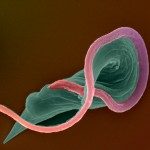Lien vers Pubmed [PMID] – 20965968
Nucleic Acids Res. 2011 Mar;39(4):1372-80
Antigenic variation in African trypanosomes is induced by DNA double-strand breaks (DSBs). In these protozoan parasites, DSB repair (DSBR) is dominated by homologous recombination (HR) and microhomology-mediated end joining (MMEJ), while non-homologous end joining (NHEJ) has not been reported. To facilitate the analysis of chromosomal end-joining, we established a system whereby inter-allelic repair by HR is lethal due to loss of an essential gene. Analysis of intrachromosomal end joining in individual DSBR survivors exclusively revealed MMEJ-based deletions but no NHEJ. A survey of microhomologies typically revealed sequences of between 5 and 20 bp in length with several mismatches tolerated in longer stretches. Mean deletions were of 54 bp on the side closest to the break and 284 bp in total. Break proximity, microhomology length and GC-content all favored repair and the pattern of MMEJ described above was similar at several different loci across the genome. We also identified interchromosomal gene conversion involving HR and MMEJ at different ends of a duplicated sequence. While MMEJ-based deletions were RAD51-independent, one-sided MMEJ was RAD51 dependent. Thus, we describe the features of MMEJ in Trypanosoma brucei, which is analogous to micro single-strand annealing; and RAD51 dependent, one-sided MMEJ. We discuss the contribution of MMEJ pathways to genome evolution, subtelomere recombination and antigenic variation.

